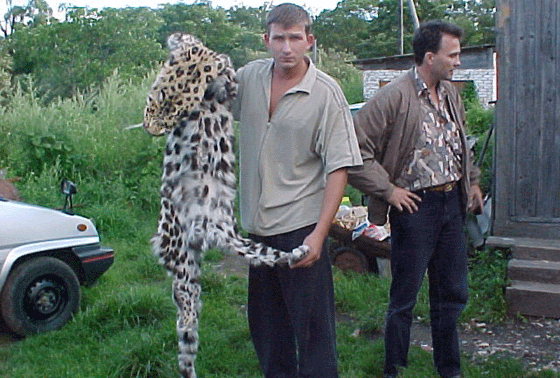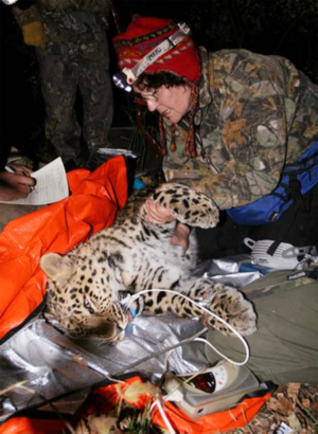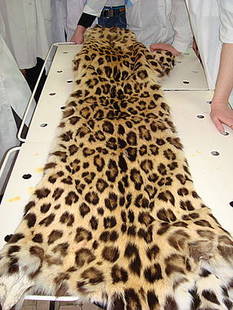Key Players
Poaching of leopard skins, like the one above, is one of the major factors
leading to the dramatic decrease in the leopard population. However, more conservation efforts, like in the picture to the right where a female Amur Leopard's health is being monitored, can help bring back this dying species. Courtesy of the Tigris Foundation and animalphiles.
leading to the dramatic decrease in the leopard population. However, more conservation efforts, like in the picture to the right where a female Amur Leopard's health is being monitored, can help bring back this dying species. Courtesy of the Tigris Foundation and animalphiles.


Many factors contribute to the extremely low population of the Amur Leopard. These include major habitat loss, poaching of leopards and leopard prey, inbreeding, and competition from their closely related Amur Tigers.
Poaching: Amur Leopards have constantly been hunted and killed for their beautiful, spotted leopard skins. They are even hunted for their bones which may be used in traditional Chinese medicine. Many hunters also poach leopards seeing them as competition for wild deer and boar. Because of the scarcity
of leopard prey, Amur Leopards can sometimes be forced to hunt on
domestic animals from local farms. And those farm owners would
then kill the leopards in retaliation. An even larger problem than the
poaching of the Amur Leopard is the poaching of their prey. The
leopard's territory is very accessible and popular for local hunters
who hunt the leopards' prey that live there.
Habitat Loss: Current programs such as gas installation plans, more road
networks, and coal mining in the Amur Leopard habitat are
reducing the already limited land suitable for leopards.
Illegal logging and deforestation are also taking away land.
Every year human-cause fires turn the leopard habitat into
grasslands and savannas, where leopards cannot live.
Inbreeding: Because of the low population of the Amur Leopard, inbreeding
can create many health problems and affect the reproduction
rates as well as the overall survival of the species.
Competition: Two species, the Amur Tiger and the Amur Leopard share
the same territory, potentially creating conflict. Research
has shown that leopards may avoid areas where the tigers
live, and that some tigers may attack and/or kill Amur
Leopards.
Conservation Efforts:
Many programs have been created to help support the Amur Leopards' survival.
Poaching: Amur Leopards have constantly been hunted and killed for their beautiful, spotted leopard skins. They are even hunted for their bones which may be used in traditional Chinese medicine. Many hunters also poach leopards seeing them as competition for wild deer and boar. Because of the scarcity
of leopard prey, Amur Leopards can sometimes be forced to hunt on
domestic animals from local farms. And those farm owners would
then kill the leopards in retaliation. An even larger problem than the
poaching of the Amur Leopard is the poaching of their prey. The
leopard's territory is very accessible and popular for local hunters
who hunt the leopards' prey that live there.
Habitat Loss: Current programs such as gas installation plans, more road
networks, and coal mining in the Amur Leopard habitat are
reducing the already limited land suitable for leopards.
Illegal logging and deforestation are also taking away land.
Every year human-cause fires turn the leopard habitat into
grasslands and savannas, where leopards cannot live.
Inbreeding: Because of the low population of the Amur Leopard, inbreeding
can create many health problems and affect the reproduction
rates as well as the overall survival of the species.
Competition: Two species, the Amur Tiger and the Amur Leopard share
the same territory, potentially creating conflict. Research
has shown that leopards may avoid areas where the tigers
live, and that some tigers may attack and/or kill Amur
Leopards.
Conservation Efforts:
Many programs have been created to help support the Amur Leopards' survival.
- World Wildlife Fund
- Amur Leopard and Tiger Alliance
- Wildlife Conservation Society Russia
- AMUR Russian Amur Tiger and Leopard Conservation
- TRAFFIC - the world's largest wildlife trade monitoring network

In Ussuriisk, Russia, police investigate the killing of this Amur Leopard after finding its pelt in a private car. Courtesy of the World Wildlife Fund.
Statistics
It is estimated that between 1970-1983, the Amur leopard lost an astonishing 80% of its former territory.
Today, the Amur leopard inhabits about 5,000 km². The last remaining viable wild population, estimated 20-25 individuals, is found in a small area in the Russian Province of Primorsky Krai, between Vladivostok and the Chinese border.
In adjacent China, 7-12 scattered individuals are estimated to remain. In South Korea, the last record of an Amur leopard dates back to 1969, when a leopard was captured on the slopes of Odo Mountain, in South Kyongsang Province.
Between February 2002 and April 2003 six Amur leopard skins were confiscated, and in January 2004 the remains of two Amur leopards shot by poachers were found, and a young female leopard was killed by a poacher in April 2007.
Today, the Amur leopard inhabits about 5,000 km². The last remaining viable wild population, estimated 20-25 individuals, is found in a small area in the Russian Province of Primorsky Krai, between Vladivostok and the Chinese border.
In adjacent China, 7-12 scattered individuals are estimated to remain. In South Korea, the last record of an Amur leopard dates back to 1969, when a leopard was captured on the slopes of Odo Mountain, in South Kyongsang Province.
Between February 2002 and April 2003 six Amur leopard skins were confiscated, and in January 2004 the remains of two Amur leopards shot by poachers were found, and a young female leopard was killed by a poacher in April 2007.